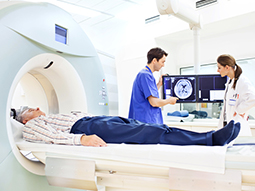An abscess is the body’s normal reaction to an infection and is caused by bacteria, fungi, parasites, or viruses. When this happens, it’s important to drain the abscess in order to prevent the infection from spreading throughout your body.
This is a procedure in which interventional radiologists remove infected fluid from the body using minimally invasive techniques. To diagnose an abscess, your doctor may use advanced imaging, such as a computed tomography (CT) scan or ultrasound, to view inside your body. Once a diagnosis is confirmed, your interventional radiologist will determine the appropriate treatment.
Why abscess drainage is performed?
Patients affected by an abscess may experience symptoms that include:
- Chills
- Fever
- Pain near the infected area
Since abscesses don’t heal on their own, the procedure is performed to remove infected fluid from the abdomen and other areas of the body before it spreads. If left untreated, abscesses can lead to long-term complications, including sepsis, which is a life-threatening infection in the bloodstream.
What to expect?
Abscess drainage generally takes less than 1 hour to complete. Unlike traditional surgery, you will not undergo general anesthesia. Instead, you will be sedated prior to the start of your procedure, which keeps you comfortable and at ease.
Next, local anesthesia will be used to numb the area of your abdomen where your interventional radiologist will make a pinhole-sized incision and insert a small needle. The needle will be guided through the abdomen using advanced imaging such as ultrasound or CT scans. You may feel some pressure, but it shouldn’t be painful.
When the needle arrives at the abscess, your interventional radiologist will exchange the needle for a thin tube called a catheter to drain the infected fluid. Once in place, the catheter may be connected to a small bag outside of your body where it will be left for a few days to ensure the abscess has time to drain completely.
Risk and benefits
Abscess drainage is a safe, minimally invasive procedure that is typically done in an outpatient setting. Since it requires only one small incision, you can expect less pain and a faster recovery compared to surgical drainage.
As with any medical procedure, there is always the possibility of complications, although unlikely. Risks may include infection or bleeding, and while rare, it’s possible for nearby organs to be damaged.
Your care team will speak with you about the risks of the procedure and the steps they will take to minimize these complications.
How to prepare?
Before your procedure, your interventional radiologist will ask you about all current medications. For example, your doctor may ask you to stop taking aspirin and blood thinners. Your care team will also communicate any restrictions on eating and drinking prior to your appointment time.
Because you will receive sedation via an intravenous (IV) line, you should not plan to drive home. Instead, make arrangements for someone else to take you home after your procedure.
If you think you might be pregnant, be sure to tell your healthcare provider. Your interventional radiologist may not be able to perform certain imaging tests during abscess drainage to protect both mother and baby.
Post abscess drainage
Because most procedures are performed in an outpatient setting, you can expect to go home the same day of your procedure, or in some cases, the next day. You may still have the drainage catheter connected to a small bag to ensure the abscess has time to drain over several days.
Your care team will advise you on when you need to come back in for them to remove the drainage catheter and bag. Upon removal of the drainage catheter, your interventional radiologist will advise you on the success of the procedure.
Most patients are able to resume normal activities within a few days following the procedure.
Our providers

Expert Interventional Radiology Care
Getting the care you need starts with seeing one of our interventional radiologists.









